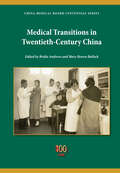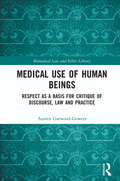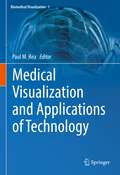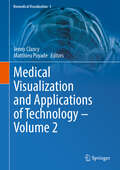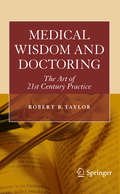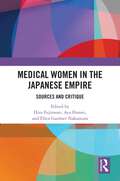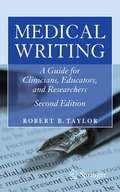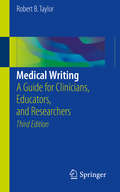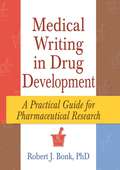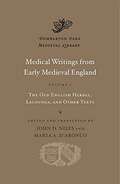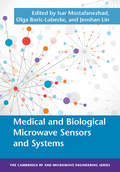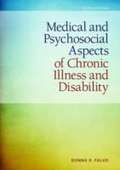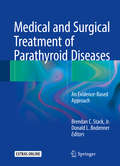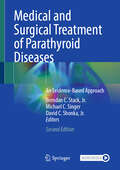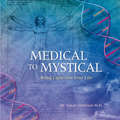- Table View
- List View
Medical Transitions in Twentieth-Century China (China Medical Board Centennial Series)
by Bridie Andrews Mary Brown Bullock“Rich insights into how one country has dealt with perhaps the most central issue for any human society: the health and wellbeing of its citizens.” —The LancetThis volume examines important aspects of China’s century-long search to provide appropriate and effective health care for its people. Four subjects—disease and healing, encounters and accommodations, institutions and professions, and people’s health—organize discussions across case studies of schistosomiasis, tuberculosis, mental health, and tobacco and health.Among the book’s significant conclusions are the importance of barefoot doctors in disseminating western medicine; the improvements in medical health and services during the long Sino-Japanese war; and the important role of the Chinese consumer. This is a thought-provoking read for health practitioners, historians, and others interested in the history of medicine and health in China.
Medical Treatment of Children and the Law: Beyond Parental Responsibilities (Biomedical Law and Ethics Library)
by Jo BridgemanThe high profile cases of Charlie Gard, Alfie Evans, and Tafida Raqeeb raised the questions as to why the state intrudes into the exercise of parental responsibility concerning the medical treatment of children and why parents may not be permitted to decide what is in the best interests of their child. This book answers these questions. It argues for a reframing of the law concerned with the medical treatment of children to one which better protects the welfare of the individual child, within the context of family relationships recognising the duties which professionals have to care for the child and that the welfare of children is a matter of public interest, protected through the intervention of the state. This book undertakes a rigorous critical analysis of the case law concerned with the provision of medical treatment to children since the first reported cases over forty years ago. It argues that understanding of the cases only as disputes over the best interests of the child, and judicial resolution thereof, fails to recognise professional duties and public responsibilities for the welfare and protection of children that exist alongside parental responsibilities and which justify public, or state, intervention into family life and parental decision-making. Whilst the principles and approach of the court established in the early cases endure, the nature and balance of these responsibilities to children in their care need to be understood in the changing social, legal, and political context in which they are exercised and enforced by the court. The book will be a valuable resource for academics, students, and practitioners of Medical Law, Healthcare Law, Family Law, Social Work, Medicine, Nursing, and Bioethics.
Medical Treatment of Glaucoma
by Xinghuai Sun Yi DaiThis book provides comprehensive information on current medications for glaucoma. From anatomy and physiology of glaucoma related ocular structure to the current mechanism theories and evaluation techniques of glaucoma, our understanding of glaucoma has been considerably improved in the last three decades. A large number of medications have been developed for the treatment of glaucoma, whose pharmacological information and data on efficacy and safety will be introduced in detail in this book. Practical guidelines for different type of glaucoma and specific patients, and pharmaceutical agents combined usage are concise and credible. The other chapters on patient managements and updates on glaucoma guidelines add useful and practical information to the book. New experimental and clinical investigations are promising and may develop new therapeutic targets for treatment of glaucoma in future.The primary target audience for this book is practicing ophthalmologists and ophthalmologists in training. Other healthcare professionals who need information about medical treatment for glaucoma may also find this book valuable. We will provide both evidence-based information and clinical experience on antiglaucoma medications, and guide the clinician on how to use them for the patient’s maximal benefit.
Medical Use of Human Beings: Respect as a Basis for Critique of Discourse, Law and Practice (Biomedical Law and Ethics Library)
by Austen Garwood-GowersWhilst activities like transplantation and medical research have typically been considered on a discrete basis, they are also actually part of a broader phenomenon of medical means being employed to make use of human beings. This book is the first ever systematic critique of such medical use of the human being as a whole. It is divided into two parts. The first part considers what constitutes an appropriate normative lens through which to view such medical use and its constraint. It makes a reasoned ethical and human-rights-based case for preferring respect for human worth over any of the main alternative approaches that have been drawn on in specific contexts and outlines what this preference practically implies. The second part uses this respect-based lens to critique use discourse, law and practice. Drawing on three contrasting case study areas of warfare-related medical use, transplantation and human tissue research, this book exposes both the context-specific and thematic nature of shortfalls in respect. Overall this book provides a compelling analysis of how medical use ought to be constrained and a compelling critique of the excesses of discourse, practice and governance. It is recommended to academics, students, policymakers and professionals whose work is focused on or intersects with the medical sector and anyone else with an interest in medicine and its limits.
Medical Uses of Statistics, 3rd Edition
by David C. Hoaglin John C. BailarA new edition of the classic guide to the use of statistics in medicine, featuring examples from articles in the New England Journal of Medicine Medical Uses of Statistics has served as one of the most influential works on the subject for physicians, physicians-in-training, and a myriad of healthcare experts who need a clear idea of the proper application of statistical techniques in clinical studies as well as the implications of their interpretation for clinical practice. This Third Edition maintains the focus on the critical ideas, rather than the mechanics, to give practitioners and students the resources they need to understand the statistical methods they encounter in modern medical literature. Bringing together contributions from more than two dozen distinguished statisticians and medical doctors, this volume stresses the underlying concepts in areas such as randomized trials, survival analysis, genetics, linear regression, meta-analysis, and risk analysis. The Third Edition includes: Numerous examples based on studies taken directly from the pages of the New England Journal of Medicine Two added chapters on statistics in genetics Two new chapters on the application of statistical methods to studies in epidemiology New chapters on analyses of randomized trials, linear regression, categorical data analysis, meta-analysis, subgroup analyses, and risk analysis Updated chapters on statistical thinking, crossover designs, p-values, survival analysis, and reporting research results A focus on helping readers to critically interpret published results of clinical research Medical Uses of Statistics, Third Edition is a valuable resource for researchers and physicians working in any health-related field. It is also an excellent supplemental book for courses on medicine, biostatistics, and clinical research at the upper-undergraduate and graduate levels. You can also visit the New England Journal of Medicine website for related information.
Medical Visualization and Applications of Technology (Biomedical Visualization #1)
by Paul M. ReaThis edited book explores the use of technology to enable us to visualize the life sciences in a more meaningful and engaging way. It will enable those interested in visualization techniques to gain a better understanding of the applications that can be used in visualization, imaging and analysis, education, engagement and training. The reader will also be able to learn about the use of visualization techniques and technologies for the historical and forensic settings. The reader will be able to explore the utilization of technologies from a number of fields to enable an engaging and meaningful visual representation of the biomedical sciences. We have something for a diverse and inclusive audience ranging from healthcare, patient education, animal health and disease and pedagogies around the use of technologies in these related fields. The first four chapters cover healthcare and detail how technology can be used to illustrate emergency surgical access to the airway, pressure sores, robotic surgery in partial nephrectomy, and respiratory viruses. The last six chapters in the education section cover augmented reality and learning neuroanatomy, historical artefacts, virtual reality in canine anatomy, holograms to educate children in cardiothoracic anatomy, 3D models of cetaceans, and the impact of the pandemic on digital anatomical educational resources.
Medical Visualization and Applications of Technology ‒ Volume 2 (Biomedical Visualization #5)
by Jenny Clancy Matthieu PoyadeThis edited volume encompasses chapters on novel and innovative research in the applications of leading digital technologies in an accessible and engaging way. By utilising cutting edge and ever progressive technology in visualization, it will enhance our understanding and application in our everyday lives. This volume shows how we can use Extended Reality, 3D animations and serious games to benefit the learner, educator, clinician, patient, parent and carer. Visualization techniques like Virtual, Augmented and Mixed Reality and show how they can be utilised to improve training and understanding of anatomy, surgery, and clinical assessment. This is covered specifically for emergency practitioners in enhancing their understanding of ECG’s for potential myocardial infarction by using augmented reality. From a translational medicine perspective and pre-operative pediatric surgical planning, the benefits of augmented reality are examined as to what might be found intra-operatively from imaging techniques. Educational applications of digital technologies using serious games and Extended Reality are examined. We show how Mixed Reality can aid understanding in cellular anatomy for our learners and researchers alike. We also show how serious games can have applications in diverse areas like parasite infections and neuroanatomy education and training. Finally, from a clinical perspective, the use of 3D animations and their applications is discussed for vertebral fractures and increasing parent/carer awareness through interactive applications. Also, the use of 3D animations in cerebral magnetic resonance angiography for global education highlights the great benefits of these tools and technologies. There is something for the researcher, clinician, educator, patient, and carer as we explore novel technologies. These are applied locally, nationally and globally as we advance our understanding of the world changing influence that digital technologies have on our day-to-day life.
Medical Wisdom and Doctoring
by Robert B. TaylorMedical Wisdom and Doctoring aims to fill a need in the current medical literature for a resource that presents some of the classic wisdom of medicine, presented in a manner that can help today's physicians achieve their full potential. This book details the lessons every physician should have learned in medical school but often didn't, as well as classic insights and examples from current clinical literature, medical history, and anecdotes from the author's long and distinguished career in medicine. Medical Wisdom and Doctoring: the Art of 21st Century Practice presents lessons a physician may otherwise need to learn from experience or error, and is sure to become a must-have for medical students, residents and young practitioners.
Medical Women in the Japanese Empire: Sources and Critique
by Aya Homei Hiro Fujimoto Ellen Gardner NakamuraFujimoto, Homei, and Nakamura bring together the perspectives of women engaging in professional medical work across the expanse of the modern Japanese Empire (1868–1945). Through translations of primary source documents in three East Asian languages, this collection provides a window into the experiences of women working in a variety of medical professions, including doctors, nurses, midwives, and nutritionists. The voices of these women, collected from books, magazines, diaries, roundtable discussions, and oral histories, speak of the challenges, hopes, triumphs, and at times despair that women faced in their medical studies and workplaces.While the women represent a kaleidoscope of political views both critical and supportive of the Japanese empire, this book demonstrates the significance of the Japanese nation and empire for many of these women. Their stories show how they pushed boundaries, traversed national or regional borders in search of medical opportunities, or attempted to carve out new spaces for women through their service as medical professionals.This work, which includes little studied sources never before accessible in English, will appeal to scholars and students of history, Asian studies, gender history/studies, and the history of science, technology, and medicine.
Medical Writing
by Robert B. TaylorThe first edition of this book (titled "The Clinician's Guide to Medical Writing") has become a standard in its field and remains an indispensible reference for any clinician, academic physician, or health professional who wishes to hone their writing skills. However, since its publication in 2004, significant changes have taken place in the way medical professionals communicate with each other and the world. Medical Writing: A Guide for Clinicians and Academicians, 2e retains all of the fundamental writing advice of the first edition and has been expanded to include two brand new chapters: How to Write a Research Protocol (including why a research project needs a written protocol, elements of the research protocol and common problems) How to Write a Grant Proposal (including sections on government and private grant funding sources, what you need to know about grant writing, and elements of a successful grant proposal) New information is also included throughout the book on becoming a successful writer, medical tables and figures, conflict of interest and disclosures, how to review a scientific article, statistical analysis, "pay-to-publish" journal publishing, electronic submission of manuscripts, issues in medical publishing and the future of medical writing and publication. New appendices address commonly encountered research and statistical terms and memorable aphorisms regarding writing, medical and otherwise.
Medical Writing
by Robert B. TaylorThis book is for the clinician who wants to write. It is for the physician, physician assistant, or nurse practitioner who sees patients and who wants to contribute to the medical l- erature. You may be an assistant professor aspiring to p- motion or a clinician in private practice who seeks the personal enrichment that writing can bring. If you are new to medical writing or even if you have been the author of some articles or book chapters and seek to improve your abilities, this book can help you. Who am I that I can make this assertion and write this book, both fairly presumptuous? Here's my reasoning. As a practicing physician, writing has been my avocation; unlike the authors of many other writing books, I am not a journal editor. Over 14 years in private practice and 26 years in a- demic medicine, I have written all the major models described in this book: review articles, case reports, edito- als, letters to the editor, book reviews, book chapters, edited books, authored books, and reports of clinical research st- ies. Most have been published. Not all. Perhaps my most signi'cant quali'cation is not that I have managed to p- duce a lengthy curriculum vitae. In my opinion, what is more important for you, the reader, is that I have made all the errors. That's right, the mistakes.
Medical Writing in Drug Development: A Practical Guide for Pharmaceutical Research
by Robert J BonkA guide through the maze of the pharmaceutical research and development process, Medical Writing in Drug Development fills a gap in the libraries of technical writers, college instructors, and corporate professionals associated with the pharmaceutical process. As it discusses critical information, such as strategies and techniques pivotal to crafting documents for drug development, it also overviews drug research, document types, the roles of professional writers, and information technology. In no time at all, you will be creating persuasive technical documents, building complex facts into coherent messages, and contributing to the effective marketing of new products with promotional pieces that meet legal and ethical standards.Medical Writing in Drug Development helps medical writers and scientific, regulatory, and marketing professionals develop a working knowledge of the technical documents crucial to successful drug research. New and seasoned professional writers alike will benefit from the book's detailed discussions of:using abstracts, slides, and posters to present up-to-the-minute researchhow patient-education materials, health-economic assessments, and electronic journals provide ongoing challenges in medical writinga dossier approach that expedites regulatory submissions for international drug developmentstructural constraints and rhetorical approaches toward regulatory documentspresenting intricate information in scientifically unbiased, yet technically convincing languagethe effects of electronic publishing, computer graphics, and related technology on the practice of medical writing within pharmaceutical researchPractical as a foundation text for undergraduate, graduate, and certificate programs in pharmaceutical or medical technical writing, Medical Writing in Drug Development will help you develop practical strategies for handling journal manuscripts, conference materials, and promotional pieces. No other text will clarify the main aspects of the pharmaceutical research and development process while offering you insight on the key issues dominating the healthcare arena.
Medical Writings from Early Medieval England Volume I
by John D. Niles Maria A. D'AroncoMedical Writings from Early Medieval England : The Old English Herbal, Lacnunga, and Other Texts -Language: old_english
Medical and Biological Microwave Sensors and Systems (The Cambridge RF and Microwave Engineering Series)
by Jenshan Lin Olga Isar Mostafanezhad Boric-LubeckeIn this comprehensive work, experts in the field detail recent advances in medical and biological microwave sensors and systems, with chapters on topics such as implantable sensors, wearable microwave tags, and UWB technology.<P><P> Each chapter explores the theory behind the technology, as well as its design and implementation. This is supported by practical examples and details of experimental results, along with discussion of system design, design trade-offs, and possible constraints and manufacturing issues. Applications described include intracranial pressure monitoring, vital signs monitoring, and non-invasive molecular and cellular investigations. Presenting new research and advances in the field, and focusing on the state of the art in medical and biological microwave sensors, this work is an invaluable resource for enthusiastic researchers and practicing engineers in the fields of electrical engineering, biomedical engineering, and medical physics.<P> Expert authors describe recent advances in state-of-the-art medical and biological microwave sensors and systems.<P> Includes practical examples and applications in biology and medicine.<P> Covers system design and design trade-offs.
Medical and Biomedical Updates (Advances in Experimental Medicine and Biology #1289)
by Mieczyslaw PokorskiThis book integrates topics in basic research and clinical medicine as well as molecular and cell biology.It presents innovative advances in the field of immunodeficiency syndromes and viral/bacterial respiratory infections, including a novel hyperbaric oxygen treatment for COVID-19. A comprehensive insight is offered into the unresolved molecular pathways in chemosensing that plays a vital role in detecting insufficient tissue oxygenation, as well as in sporting accomplishments. Other articles address cardiorespiratory and humoral responses to hypoxia, the function of cementum in the repair and regeneration of teeth, and periprosthetic fractures following hip arthroplasty in the elderly. The issue of the overwhelming burdens on caregivers to spinal injury patients, damaging both health and psychosocial status, is addressed.The book promotes translation of scientific advances to the general medical practice. It will be a valuable reference for clinical healthcare professionals and researchers interested in innovative practices to improve the prevention, diagnosis, and management of diseases.
Medical and Mental Health During Childhood
by Laura NaborsThis textbook provides a comprehensive overview of medical and mental illness in children, detailing how psychological, academic, and social functioning can be enhanced - and inherent challenges overcome - in young patients. The volume describes best-practices in depth, including how to ensure accurate diagnosis, developmentally appropriate treatment, and effective coordination between medical and school personnel. It discusses common medical conditions (e. g. , asthma, cancer, diabetes) and mental health conditions (e. g. , autism, ADHD, depression), emphasizing the critical role of health education in promoting optimal outcomes. Topics featured in this text include: Screening and diagnosis practices for children with medical and mental illness. Chronic and condition-related pain in children. Medical fears that may interfere with treatment and positive health behaviors Health education and coping strategies for children. Recommendations for family-directed interventions. Illustrative case studies and review questions. Medical and Mental Health During Childhood is an essential text for graduate students as well as a valuable reference for researchers, professors, and clinicians in clinical child and school psychology, social work, public health, family studies, educational psychology and counseling, health education, and allied disciplines.
Medical and Psychological Effects of Concentration Camps on Holocaust Survivors: A Research Bibliography (Genocide Ser. #Vol. 4)
by Robert Krell & Marc I. ShermanThis unique research bibliography is offered in honor of Leo Eitinger of Oslo, Norway. Dr. Eitinger fled to Norway in 1939, at the start of the World War II. He was caught and deported to Auschwitz, where, among others, he operated on Elie Wiesel who has written the foreword to this volume. After the war, Eitinger became a pioneering researcher on a subject from which many shied away. His contributions to understanding of the experience of massive psychological trauma have inspired others to do similar work. His many books and papers are listed in this special volume of the acclaimed bibliographic series edited by Israel W. Charny of The Institute on the Holocaust and Genocide in Jerusalem.In order to acquaint users of this bibliography with the topic, two introductory articles are offered. The first is titled "Survivors and Their Families" and deals with the impact of the Holocaust on individuals. The second, "Psychiatry and the Holocaust," examines the general impact of the Holocaust on the field of psychiatry. Robert Krell writes that in general the psychiatric literature has reflected critically on the survivor due to preconceived notions held by many mental health professionals. For many years, the exploration of victims' psychopathology obscured the remarkable adaptation made by some survivors. The problems experienced by survivors and possible approaches to treatment were entirely absent from mainstream psychiatric textbooks such as the Comprehensive Textbook of Psychiatry throughout the 1960s and 1970s.Fifty years of observations about survivors of the concentration camps and other survivors of the Holocaust (in hiding, as partisans, in slave labor camps) has provided a new body of medical and psychiatric literature. This comprehensive bibliography contains a plethora of references to significant pieces of literature regarding the Holocaust and its effects on survivors. It will be of inestimable value to physicians, psychiatrists, psychologists, and social workers, along with historians, sociologists, and Holocaust studies specialists.
Medical and Psychosocial Aspects of Chronic Illness and Disability (4th Edition)
by Donna R. FalvoMedical and Psychosocial Aspects of Chronic Illness and Diseases, Fourth Edition covers the medical aspects of those conditions commonly encountered by rehabilitation and other health professionals and discusses symptoms, diagnoses, treatments, and prognoses. This Fourth Edition has been completely revised and updated and reflects an approach consistent with the philosophical underpinnings of the International Classification of Functioning, Disability and Health (ICF). New chapters on Conceptualizing Chronic Illness and Disability; Intellectual Disability; and Financing Rehabilitation have been added. In addition, chapters on Psychiatric Disability, Substance Use, and Conditions of the Blood and Immune System have been expanded
Medical and Psychosocial Aspects of Chronic Illness and Disability (Fifth Edition)
by Donna R. FalvoThis book is designed as a reference for non-medical professionals and as a text for students who have little prior medical knowledge but who work with individuals with chronic illness and disability.
Medical and Surgical Complications of Sickle Cell Anemia
by Ahmed Al-SalemThis book is a wide-ranging guide to the diagnosis and management of the numerous medical and surgical complications that may arise in patients with sickle cell anemia. After introductory chapters on the genetics, pathophysiology, clinical features, and variants of sickle cell anemia, the complications observed in different parts of the body are addressed in a series of well-illustrated chapters. The coverage includes splenic, hepatobiliary, musculoskeletal, gastrointestinal, ophthalmological, cardio- and cerebrovascular, and renal complications, as well as acute chest syndrome, leg ulcers, hand and foot syndrome, acute appendicitis, and priapism. Treatment-oriented chapters consider perioperative management, blood transfusion therapy, hydroxyurea treatment, hematopoietic stem cell transplantation, and emerging strategies. The book is clearly written in a distinctive bullet point format for ease of reference and emphasizes especially aspects of practical significance. It will be of value for hematologists, general surgeons, internists, pediatricians, pediatric surgeons, fellows, residents, medical students, and nurses.
Medical and Surgical Emergencies for Students and Junior Doctors
by Neel Sharma Faye Hill Sash NoorLack of exposure and patient management during undergraduate and early postgraduate training often means both students and junior doctors can have difficulty managing acute medical and surgical situations. This pocketbook provides comprehensive coverage of the common medical and surgical emergencies encountered by medical students and junior doctors. It outlines possible symptoms, signs, differentials, investigations and management in a succinct, easy to comprehend format. By focusing on evidence-based practice, the guide provides the most up-to-date and clinically relevant guide for today's practice, ideal for quick reference on the wards.
Medical and Surgical Treatment of Parathyroid Diseases
by Jr. Brendan C. Stack Donald L. BodennerMedical and Surgical Treatment of Parathyroid Diseases is an accessible and user-friendly guide, addressing the key points of parathyroid diseases using case studies, as well as hundreds of high quality images and illustrations. Written and edited by respected leaders in the field of parathyroid surgery, this book aids in the comprehension of innovative concepts and focuses on the latest in clinical research. Written for otolaryngologists and oncologists at various stages of experience, Medical and Surgical Treatment of Parathyroid Diseases includes chapters dedicated to parathyroid anatomy, physiology, and embryology, medical therapy for parathyroid disease (indications and pharmacotherapy), diagnostic imaging, surgical treatments, and special topics such as health services and healthcare economics related to parathyroid surgery.
Medical and Surgical Treatment of Parathyroid Diseases: An Evidence-Based Approach
by Michael C. Singer Brendan C. Stack Jr. David C. Shonka Jr.Now in a revised and updated second edition, this text remains a comprehensive resource for the medical and surgical management of diseases of the parathyroid, divided into five thematic sections. Part one provides a general introduction to the parathyroid, including presentation and diagnosis of hypercalcemia and primary, secondary and tertiary hyperparathyroidism. Parathyroid imaging is presented in part two, including ultrasound, CT, PET, and angiography and venous sampling. Parts three and four comprise indications and techniques for parathyroid surgery, and part five expands on surgical adjuncts including intraoperative monitoring, radioguidance, auto- and allotransplantation, and more. In addition, there is a supplemental collection of video segments demonstrating many of the surgical techniques described in earlier chapters. Written and edited by experts in the field, Medical and Surgical Treatment of Parathyroid Diseases, Second Editions remains a sterling resource for surgeons, otolaryngologists and oncologists at various stages of experience.
Medical to Mystical
by Susan JamiesonBiology, physiology, and physics combine with ancient traditions to explore the science of enlightenment-the interconnectedness of humanity and nature through the oneness of light-in this practical, spiritual guidebook. Written by a medical doctor who has embraced the spiritual side of healing, this analysis escorts readers on a journey through the light of DNA and physiological processes and connects this light to the Earth and the sun. Simple exercises show how to absorb, share, and hold the light, illustrating that manifesting its oneness will connect humans with each other as well as with nature. Touching on several aspects of healing-including chakras, Chinese meridians, earth and body energies, and Qi Gong-this part-medical, part-metaphysical guide illustrates that the science of enlightenment leads to personal and global well-being.
Medical, Psychosocial And Vocational Aspects Of Disability
by Martin Brodwin John Howard Frances Siu Erin Brodwin Ashley DuMedical, Psychosocial and Vocational Aspects of Disability (4th Ed. )
